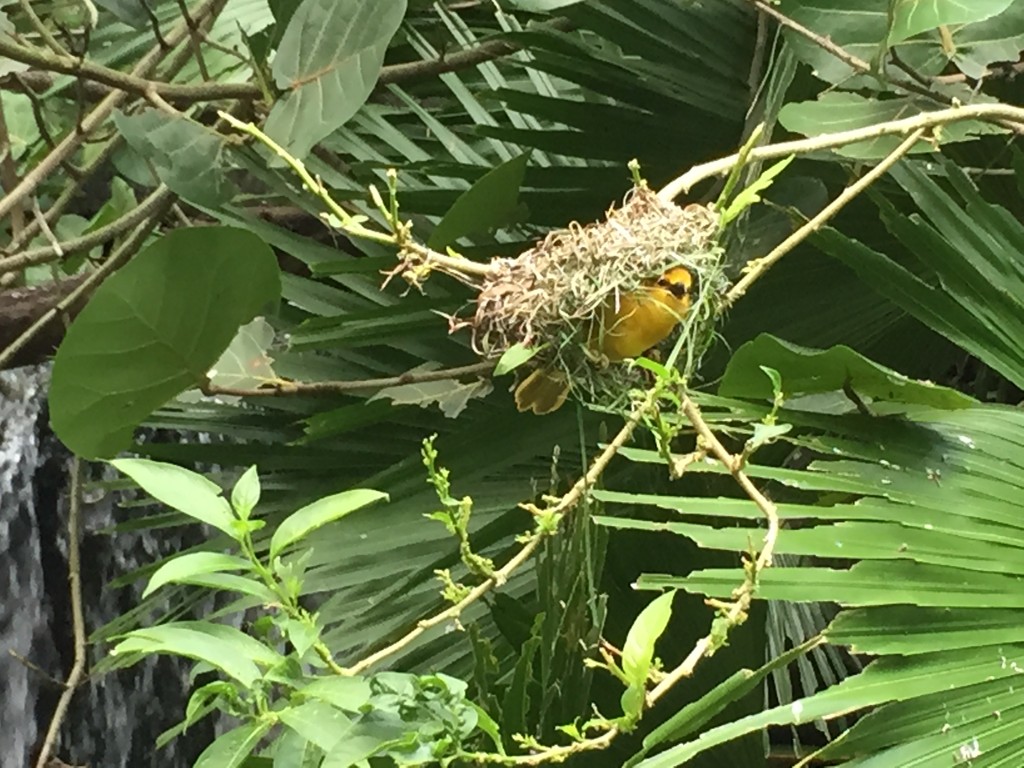Written by Gabe, a Monthly Correspondent and Ursids alumni, this post talks about a showy and industrious relative of the sparrow – the Taveta Golden Weaver. While their song might not be “music” to our ears, they are still interesting and showy little songbirds!

This stunning bird is found in eastern Africa along the coast from Tanzania to Kenya. They reside in woodland, swampy areas, and bulrushes, and some species very closely related to this bird have been found in Asia. The sparrow’s close relative is small, around the size of a finch.
The Golden Weaver is named quite appropriately; the birds are known to weave intricate nests, and for the most part have a yellow-golden color, sometimes with unique colorations of rust orange rings and spots. The male is a bright, vibrant yellow-gold color, and this color dulls on its back. The wings and tail are slightly green in color. The female is more of an olive color with streaks of yellow through its feathers.
The weaver eats seeds mostly, and its offspring receive food from their mother like other species of birds. If the bird cannot access seeds it will eat corns and grasses.
The Taveta Weaver live in colonies; males make oval-shaped nests over water attached to low hanging trees, grasses, or reeds. They have strong claws and beaks which enable them to weave intricate nests. The male’s ability to make a nest is pivotal! This is how the female choses who she will mate with, the male’s skill impresses the female into mating. These nests can fill an entire tree! The weaver is considered a songbird, but its “song” is not pleasing to humans and could be described as a high pitched squeak.
The weavers lay 2 or 3 glossy, dark, olive-colored eggs and weavers commonly breed within their colonies. The Taveta weaver is not currently endangered.
The Taveta Golden Weaver – scientific name: Ploceus castaneiceps
Posted: January 28, 2016 by Katie Cassidy
Written by Gabe, a Monthly Correspondent and Ursids alumni, this post talks about a showy and industrious relative of the sparrow – the Taveta Golden Weaver. While their song might not be “music” to our ears, they are still interesting and showy little songbirds!
This stunning bird is found in eastern Africa along the coast from Tanzania to Kenya. They reside in woodland, swampy areas, and bulrushes, and some species very closely related to this bird have been found in Asia. The sparrow’s close relative is small, around the size of a finch.
The Golden Weaver is named quite appropriately; the birds are known to weave intricate nests, and for the most part have a yellow-golden color, sometimes with unique colorations of rust orange rings and spots. The male is a bright, vibrant yellow-gold color, and this color dulls on its back. The wings and tail are slightly green in color. The female is more of an olive color with streaks of yellow through its feathers.
The weaver eats seeds mostly, and its offspring receive food from their mother like other species of birds. If the bird cannot access seeds it will eat corns and grasses.
The Taveta Weaver live in colonies; males make oval-shaped nests over water attached to low hanging trees, grasses, or reeds. They have strong claws and beaks which enable them to weave intricate nests. The male’s ability to make a nest is pivotal! This is how the female choses who she will mate with, the male’s skill impresses the female into mating. These nests can fill an entire tree! The weaver is considered a songbird, but its “song” is not pleasing to humans and could be described as a high pitched squeak.
The weavers lay 2 or 3 glossy, dark, olive-colored eggs and weavers commonly breed within their colonies. The Taveta weaver is not currently endangered.
Category: Youth Blog Tags: birds, Bucktails, education, exotic animals, habitat, nature observation, Ursids, wildlife, youth